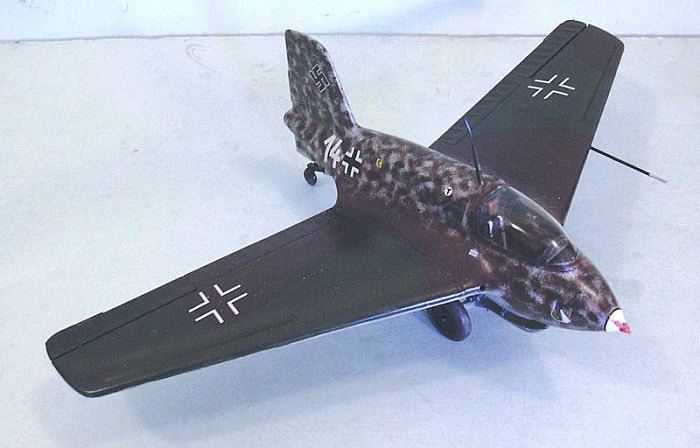
Hasegawa 1/32 Me-163B
| KIT #: | 08177 |
| PRICE: | $39.95 MSRP |
| DECALS: | Four Options |
| REVIEWER: | Tom Cleaver |
| NOTES: | OOP Eagle Strike resin cockpit used |

| HISTORY |
Alexander Lippisch had a long history in creating tailless or all‑wing gliders during the 1920s, leading to the creation of some of the most high‑performance gliders ever seen. His first involvement with rocket power was in 1928, when he used solid‑ fuel rockets as a method for launching a glider. In the 1930s, Lippisch worked with the Deutsche Forschungsanstalt fur Segelflug ‑ the German Glider Research Institute ‑ in developing even more advanced gliders and powered aircraft. In 1938, he was asked by the RLM to research the application of Helmuth Walter's bi‑fuel controllable rocket motor for aircraft propulsion. The D.F.S. did not have the facilities for construction of such an aircraft, and Lippisch began his association with Messerschmitt in January 1939. The result of this work was the development of the Me‑163 rocket‑powered point‑defense interceptor, later that year.
German military successes in 1939‑40 slowed the development of the
Me‑163A, which did not fly until August 13, 1941. By September, speeds of 500
m.p.h. were achieved with ground takeoffs. Test pilot Heini Dittmar
complained that the fuel supply was so small that the aircraft was still
accelerating when it ran out of fuel. On October 2, 1941, Me‑163A CD+IM was
towed aloft by a Bf‑110E over Peenemunde and cast loose at 13,000 feet, where
Dittmar switched on the motor. At approximately 600 m.p.h.,
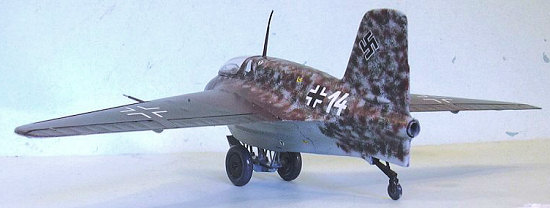 Dittmar lost control due to
compressibility effects. As it plunged into a dive, he turned off the engine,
regained control, and executed a normal landing. Technical instruments showed
he had achieved 623.85 m.p.h., or Mach 0.84 ‑ the fastest speed ever achieved
in level flight by an aircraft to that date.
Dittmar lost control due to
compressibility effects. As it plunged into a dive, he turned off the engine,
regained control, and executed a normal landing. Technical instruments showed
he had achieved 623.85 m.p.h., or Mach 0.84 ‑ the fastest speed ever achieved
in level flight by an aircraft to that date.
The Me‑163B was designed in 1941, as a combat-worthy variant. Armed with two 30mm cannon and carrying an increased fuel load, it was to be used as a point defense fighter. The Me‑163B V1 was first flown on June 26, 1942 in unpowered flight. The first powered flight occurred on February 21, 1943, using the "cold" R II‑209 rocket motor. This motors was extremely dangerous, since it was fueled with "T‑Stoff" (80% hydrogen peroxide) and "C Stoff" (an aqueous solution of sodium permanganate), which literally exploded when brought into contact with each other - even a minute quantity could cause a fatal explosion.
The 8th Air Force raid on the Messerschmitt factory at Regensburg on August 17, 1943, was nearly fatal to the Me‑163 program, with 11 Me‑163B‑0s destroyed. The factory was dispersed and major construction responsibility for the Me‑153 was given to Klemm, a small company inexperienced in modern mass‑production aircraft construction techniques. Though Junkers would later be brought in to manage production, the problems would never be successfully resolved. The RAF raid that same night on the Peenemunde research station resulted in the Me‑163 program being moved to another research station in eastern Germany; both of these events delayed production and introduction of the fighter operationally. The first operational unit was formed in January 1944 under the command of Hauptmann Wolfgang Spate ‑ the man more responsible than anyone for what little success the program ever achieved ‑ who wanted to set up rings of large bases within gliding distance of each other along the major bomber routes in western, north‑western and northern Germany for use by the proposed force of 1,000 Me‑163s scheduled to be operational by the summer of 1944.
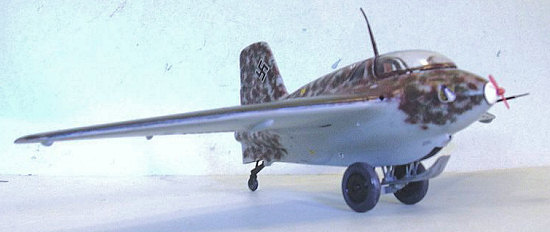 Fortunately for the
Allied air campaign, Klemm was completely incapable of achieving the necessary
production rate and the definitive Walter 109‑509 rocket engine continued to
prove difficult to use. Initial tests showed that as the aircraft nosed over
from its initial zoom climb, the engine would shut off prematurely, which was
traced to an automatic cutoff for the T‑Stoff and C‑Stoff; as the aircraft
nosed over, the fuel sloshed in the tanks and the fuel outlet of one or the
other would become air locked, with the result that the automatic system cut
off the engine to prevent explosion. Rules for takeoff were that if the pilot
was not airborne at the first marker on the field, he could shut off the
engine and come to a stop; if not airborne by the second marker, the pilot was
to open the canopy, climb onto the wing and pull his ripcord to escape,
because, when the aircraft crashed at the end of the field, an explosion was
inevitable when the two fuels came together. If all the fuel was not used in
flight, there was also the possibility of an explosion on touchdown.
Fortunately for the
Allied air campaign, Klemm was completely incapable of achieving the necessary
production rate and the definitive Walter 109‑509 rocket engine continued to
prove difficult to use. Initial tests showed that as the aircraft nosed over
from its initial zoom climb, the engine would shut off prematurely, which was
traced to an automatic cutoff for the T‑Stoff and C‑Stoff; as the aircraft
nosed over, the fuel sloshed in the tanks and the fuel outlet of one or the
other would become air locked, with the result that the automatic system cut
off the engine to prevent explosion. Rules for takeoff were that if the pilot
was not airborne at the first marker on the field, he could shut off the
engine and come to a stop; if not airborne by the second marker, the pilot was
to open the canopy, climb onto the wing and pull his ripcord to escape,
because, when the aircraft crashed at the end of the field, an explosion was
inevitable when the two fuels came together. If all the fuel was not used in
flight, there was also the possibility of an explosion on touchdown.
On May 13, 1944, Spate flew the first combat mission from Bad Zwischenahn in the Me‑163B V41. As he began an attack on two P‑47s, he inadvertently maneuvered the airplane so that the engine cut out. With two P‑47s above and the two ahead, he maintained his glide for the two minutes it took for the engine to clear for a re‑start, which he achieved without harm. As he closed in again at an indicated airspeed of 550 m.p.h., the Me‑163 suddenly snapped to the left and began vibrating due to compressibility. Spate had just run into "the sound barrier" and exceeded his Me‑163s limiting Mach number! He was able to regain control as the airplane slowed, and made a successful landing. Five other missions were flown in May; none were successful in intercepting enemy aircraft.
The Me‑163 was first used against USAAF bombers on July 28, 1944, when four
from EK16 ‑ the development unit ‑ were encountered by the P‑51 escort; one
other made an attack on a damaged B‑17 escorted by P‑38s of the 479th FG. The
8th Air Force visited Bad Zwischenahn on August 15, badly damaging the base
and reducing the number of serviceable Me‑163s to six; further flights could
not be made until mid‑September.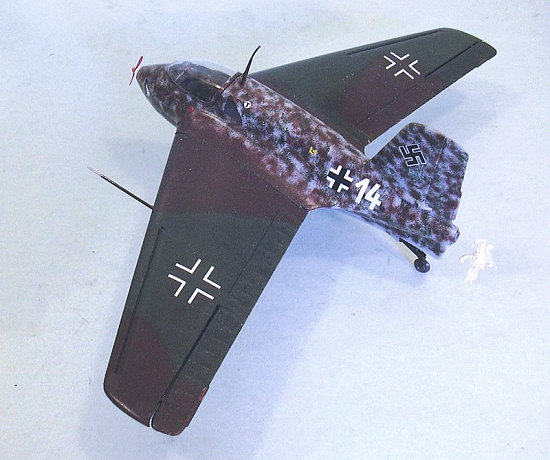
While the Me‑163 was a good gun platform, it was difficult for any but the most experienced pilot to make a successful attack, since it was necessary to make the approach at 550‑580 m.p.h. to outrun the escorts, giving a closing rate on the bombers of 500 feet per second. Accurate fire could only be opened at ranges under 650 yards. To avoid the possibility of collision, the pilot had to break off the attack and commence a dive no closer than 200 yards to the target. This gave him less than two seconds to assess range and deflection, and less than one second to open fire.
I/JG400 ‑ the first operational unit ‑ had its most successful sortie on August 24, 1944, when Feldwebel Schubert and his wingman shot down a B‑17. Other Me‑163s of the unit shot down an additional 3 B‑17s. On August 26, the factory producing the C‑Stoff was destroyed by Allied bombing, while several tanker trains of fuel were lost to air attacks. From late September on, only occasional missions could be flown as a result of these events. Winter knocked the Me‑163 out of service completely, since it could only be flown in conditions of good visibility. A few missions were flown against reconnaissance aircraft in the spring of 1945, but there were no claimed victories.
On May 8, 1945, Hauptman Rudolf Opitz's II/JG400 surrendered with 48 Me‑163Bs to the RAF Regiment in Schleswig‑Holstein. 25 of these aircraft were taken over by the British, with four handed over to the French. Others found in Bavaria were taken byUS forces, while an unknown number were captured at the Junkers factory by the Soviets.
After the war, the British did some unpowered test flights with their Me-163Bs, and it is rumored that at least one Me-163B was flown under power in the United States. It is unknown what the Soviets did with theirs, but it was rumored in the late 1940s that they were going to produce the Me-263 (with tricycle landing gear) as a defense against B-29s, but this never happened. The development of jet engines was already at such a state that a dangerous rocket propelled point defense interceptor was no longer necessary for any air force. Unfortunately, the Lippisch tailless design was seen as being useful for high speed flight despite its record of losing control; Geoffrey deHavilland lost his life in the D.H.108, an airplane that was nearly a direct copy of the Me-163 (other than being jet-powered), when he exceeded the limiting Mach number as Spate had done three years earlier.
The Germans had provided the Me‑163 to the Japanese in 1944, transporting plans by U‑boat. The J8M1 Shusui was approaching flight status at the end of the Pacific War; the one and only complete J8M1 became the first airplane acquired by Ed Maloney when he purchased it for $100 as scrap from NAS Los Alamitos in 1947; today it is on display at the Air Museum, Planes of Fame, hanging from the ceiling of the North Hangar over a 1:1 wooden model of a Me-163B. Ten Me‑163s exist at museums around the world.
| THE KIT |
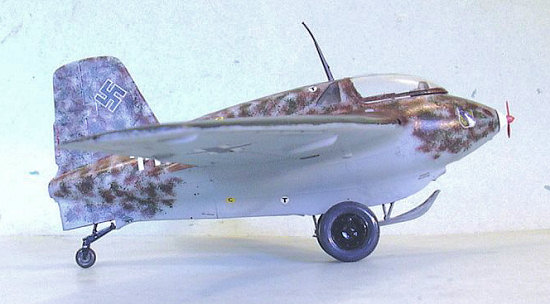 Hawk (later Testor) first
released a 1/48 kit of an Me-163B in the late 1950s that is still released,
and Dragon did one in the early 1990s that is the best Me-163 in 1/48, while
Heller did one in 1/72 in the mid 1970s. (Kits by Lindberg and Academy are
also available in 1/72 with the Academy version being probably the best of the
bunch. Ed) However, the 1/32 kit Hasegawa first released in 1973 was -
and still is - the most detailed and accurate kit of this airplane available
in any scale.
Hawk (later Testor) first
released a 1/48 kit of an Me-163B in the late 1950s that is still released,
and Dragon did one in the early 1990s that is the best Me-163 in 1/48, while
Heller did one in 1/72 in the mid 1970s. (Kits by Lindberg and Academy are
also available in 1/72 with the Academy version being probably the best of the
bunch. Ed) However, the 1/32 kit Hasegawa first released in 1973 was -
and still is - the most detailed and accurate kit of this airplane available
in any scale.
When my friend Gary Boyd sent me the now long out of production Eaglestrike resin cockpit for this model, I knew it was a matter of time before I did one again, having done one when it was first released 34 years ago, and another about 10 years ago for Ed Maloney that is now on display at Planes of Fame. I took a look at kits I ran across at various shows, but the decals did not age well, and there are no 1/32 aftermarket decals for this kit I am aware of. A few weeks ago I walked into my local hobby shop and found one kit of this re-release. The decals were the new Hasegawa kind. While $39.95 is perhaps expensive for this kit (you can commonly get them for $20 at shows), I was willing to spring for it with the good decals and what I discovered was the good plastic.
On opening the box, I was pleasantly surprised to discover that this is a new-production kit. It has been my experience, picking up re-releases of Hasegawa kits from the 1970s, that they are the original brittle plastic (probably actually produced back then and held in storage) Hasegawa was famous for then. This re-release has modern, softer plastic, which makes for a much more enjoyable building process.
| CONSTRUCTION |
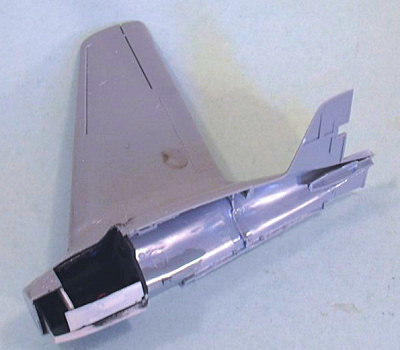 I
started by gluing the wings together. Back then, Hasegawa did not have the
mold capability of getting the trailing edges really thin with separate parts,
so they molded the trailing edge and about 1/4 inch of the lower surface
integral with the upper part. With 1970s kit design, this usually means a
gap, which can be problematic when it runs through fabric surface detail, as
it does on this kit. Fortunately, by scraping down the edge of the lower
piece, and using hot glue that melts the plastic together, I pressed the parts
together and got a tight seam I could get rid of with the tip of a #11 X-acto
blade.
I
started by gluing the wings together. Back then, Hasegawa did not have the
mold capability of getting the trailing edges really thin with separate parts,
so they molded the trailing edge and about 1/4 inch of the lower surface
integral with the upper part. With 1970s kit design, this usually means a
gap, which can be problematic when it runs through fabric surface detail, as
it does on this kit. Fortunately, by scraping down the edge of the lower
piece, and using hot glue that melts the plastic together, I pressed the parts
together and got a tight seam I could get rid of with the tip of a #11 X-acto
blade.
Since I was going to make this model buttoned up, I attached the rear fuselage parts to the forward parts at this stage, so I could work on fit from inside and out and get it nice and smooth. It turns out that the fit of this kit is really good in this area, since it was originally designed to allow a modeler to remove the tail to display the nicely-detailed rocket motor, with the tail able to be attached and look good. You can still do that with this kit if you have a mind to.
The
big departure was using the resin cockpit, which was really quite simple once
I cut the tub off its mold block. I painted the interior with Xtracrylix
RLM66 Schwarzgrau, and drybrushed Tamiya Aluminum to
pop out
detail. I considered sanding off the molded-on seatbelts and replacing them
with Eduard photoetch 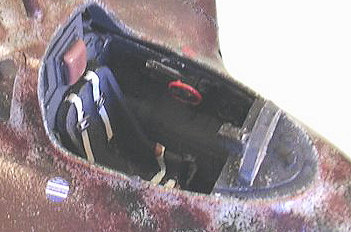 seatbelts,
but decided that since I was going to close the canopy - the Me-163 being one
model that looks much better with the canopy closed - that I didn=t need the
extra detail. If you do one and plan to open the canopy, I would suggest
using the Eduard belts, particularly if you are going to use the kit cockpit.
The kit cockpit is OK, and will look all right when painted, and the photoetch
seatbelts will add that final
touch to things that will bring things
right up to date.
seatbelts,
but decided that since I was going to close the canopy - the Me-163 being one
model that looks much better with the canopy closed - that I didn=t need the
extra detail. If you do one and plan to open the canopy, I would suggest
using the Eduard belts, particularly if you are going to use the kit cockpit.
The kit cockpit is OK, and will look all right when painted, and the photoetch
seatbelts will add that final
touch to things that will bring things
right up to date.
When I glued the cockpit in place and then glued the fuselage halves together, I got a chance under the light to realize just how good and how appropriate the raised-line detail is for this. The Me-163 was very smooth, so engraved lines would really detract, and Hasegawa did the molding in a way that shows the lapped panels on the upper fuselage to a very good effect. Those modelers who say this old kind of surface detail is Aunacceptable@ mostly don=t know what they=re talking about, given that the result - like this - is often far more realistic and accurate in its look when completed.
With careful test-fitting, the wings went on without any need of gap-filler, other than the hot glue.
I Futured the canopy, which made it sparkling clear and got rid of enough of the molding distortion to allow the interior to be seen with the canopy closed. I masked it and tacked it in position for painting.
Given that there were only 10 parts to the airframe and about the same number for the resin cockpit, the model came together very quickly over a weekend (important to me now that my modeling time is limited), and was ready for painting.
| COLORS & MARKINGS |
Painting:
I decided to do the Me-163B Weiss Vierzehn from I/JG400, since the original was well-photographed, providing the documentation to do the camouflage and markings. I also like the squadron slogan, AWie ein floh, aber oho!@ (Like a flea, but watch out!).
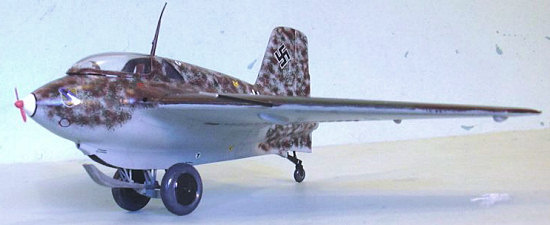 After
pre-shading the model with Tamiya flat black, I painted everything but the
upper wings with Xtracrylix RLM76 Lichtblau. The wings were painted
with RLM81 Braunviolett and RLM82 Dunkelgrun, while the fuselage
was heavily dappled with RLM81 and RLM82, per the photographs.
After
pre-shading the model with Tamiya flat black, I painted everything but the
upper wings with Xtracrylix RLM76 Lichtblau. The wings were painted
with RLM81 Braunviolett and RLM82 Dunkelgrun, while the fuselage
was heavily dappled with RLM81 and RLM82, per the photographs.
After the paints had dried, I gave the model a coat of Xtracrylix Gloss Varnish.
Decals:
The kit decals went down without problem, but these were the first Hasegawa decals I have ever had to let soak for an extended period before getting them loose. I also needed a lot of water over the surface I was applying them to, so I could position them. The decals are quite thin and need to be handled carefully. They went down without a problem under a coat of Micro-sol.
| FINAL CONSTRUCTION |
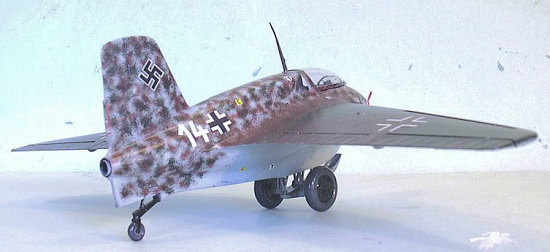 Point Cook Air Museum used to
have two Me-163Bs that were in their original paint under a coat of thick wax,
before they were repainted incorrectly in the 1970s. Fortunately, color photos
of the airplanes in their original paint scheme are in Merrick=s
Luftwaffe Camouflage and Markings,
1943-45, and I could see these airplanes
had little weathering on them. Given that the original Weiss Vierzehn may never
have flown operationally, I left the model clean and applied a coat of
Xtracrylix Satin Varnish to it, since the originals were all waxed for better
performance. I then attached the landing skid, and then the takeoff trolley,
and unmasked the canopy.
Point Cook Air Museum used to
have two Me-163Bs that were in their original paint under a coat of thick wax,
before they were repainted incorrectly in the 1970s. Fortunately, color photos
of the airplanes in their original paint scheme are in Merrick=s
Luftwaffe Camouflage and Markings,
1943-45, and I could see these airplanes
had little weathering on them. Given that the original Weiss Vierzehn may never
have flown operationally, I left the model clean and applied a coat of
Xtracrylix Satin Varnish to it, since the originals were all waxed for better
performance. I then attached the landing skid, and then the takeoff trolley,
and unmasked the canopy.
| CONCLUSIONS |
Time has been kind to the Hasegawa Me-163, and it is unlikely to be done better in this scale by anyone. The model is accurate, easy to do, and looks very nice sitting next to the Trumpeter Me-262s and the Revell He-162A. If you=re looking for an easy project that will look good when completed, you could do far worse than pick one of these up - for the quality of the plastic and the decals, the reissued kit is not overpriced even at US prices, and if you get it from HLJ with the current exchange rate, it=s a real bargain.
Copyright ModelingMadness.com. All rights reserved. No reproduction in part or in whole without express permission from the editor.
November 2007
If you would like your product reviewed fairly and quickly, please contact the editor or see other details in the Note to Contributors.
Back to the Review Index Page 2023